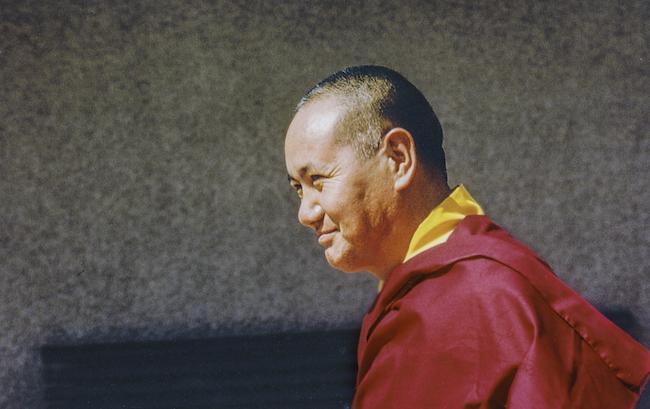Dear Friends,
Thank you so much for your interest in the Lama Yeshe Wisdom Archive and for subscribing to our monthly eletter. Please feel free to share it widely!
In this month's issue we have news to share about the launch of the new Lamrim Year Companion site, a new free audiobook, the latest installment of the Big Love homemade audiobook, as well as a new video, podcast and advices.
We are also very happy to inform you that LYWA’s forthcoming book of teachings by Lama Yeshe, Knowledge-Wisdom: The Peaceful Path to Liberation, is about to go to the printers and due out early 2023. Check out an excerpt from this book in our monthly teaching below.
The new Lamrim Year Companion Site
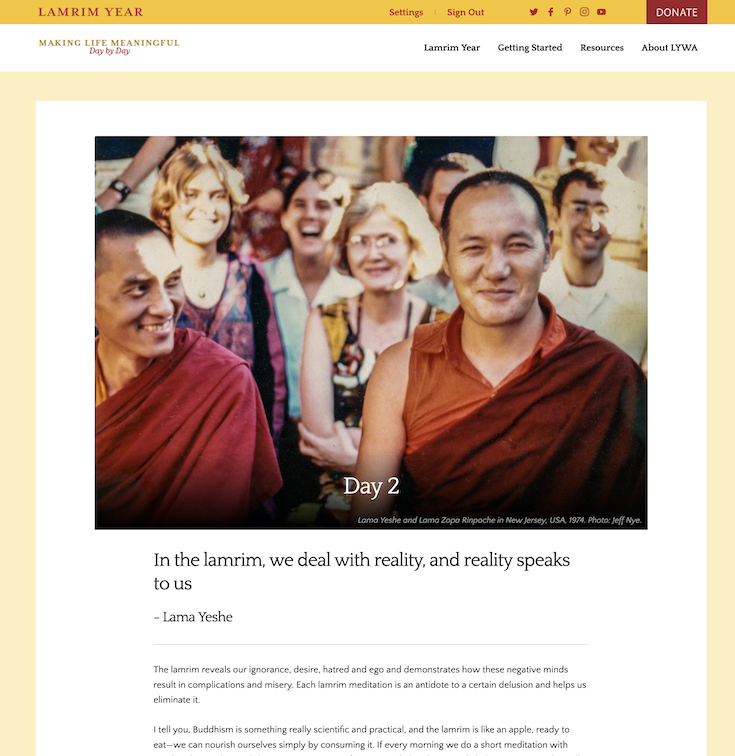 In case you missed the big news, the FREE Lamrim Year Companion has officially launched! The popular LYWA publication Lamrim Year now has a companion website designed to help you access Lamrim Year‘s daily meditations from wherever you are, whether on a desktop computer or on a mobile device. You'll discover that the new companion site:
In case you missed the big news, the FREE Lamrim Year Companion has officially launched! The popular LYWA publication Lamrim Year now has a companion website designed to help you access Lamrim Year‘s daily meditations from wherever you are, whether on a desktop computer or on a mobile device. You'll discover that the new companion site:
- tracks your progress as you go through each lamrim topic
- supports additional study on each lamrim topic by emailing teachings, resource links, and inspiring quotes and images
- provides the option to record personal notes and insights on each Day
- connects you to the full scope of related Lamrim Year resources on the LYWA website
Start using the new Lamrim Year Companion site today! If you are already working through Lamrim Year, please contact us and we can set you up to continue from whichever Day you’re on. And please consider making a donation to the Archive to support this special project. Thank you!
FROM THE VIDEO ARCHIVE: Teachings on the Heart Sutra
This month from the video archive, the first installment of teachings by Lama Zopa Rinpoche on the Heart Sutra. In this opening teaching Rinpoche points out how extremely rare it is to receive teachings on emptiness and how these teachings will protect us from falling prey to ignorance, the cause of all our problems and sufferings. These teachings were hosted by Tara Institute in Melbourne, Australia, March, 2000.
Visit and subscribe to the LYWA YouTube channel to view more videos freely available from our archive. See also the FPMT YouTube channel for many more videos of Lama Zopa Rinpoche’s teachings.
On the LYWA Podcast: Realizing The Lamrim
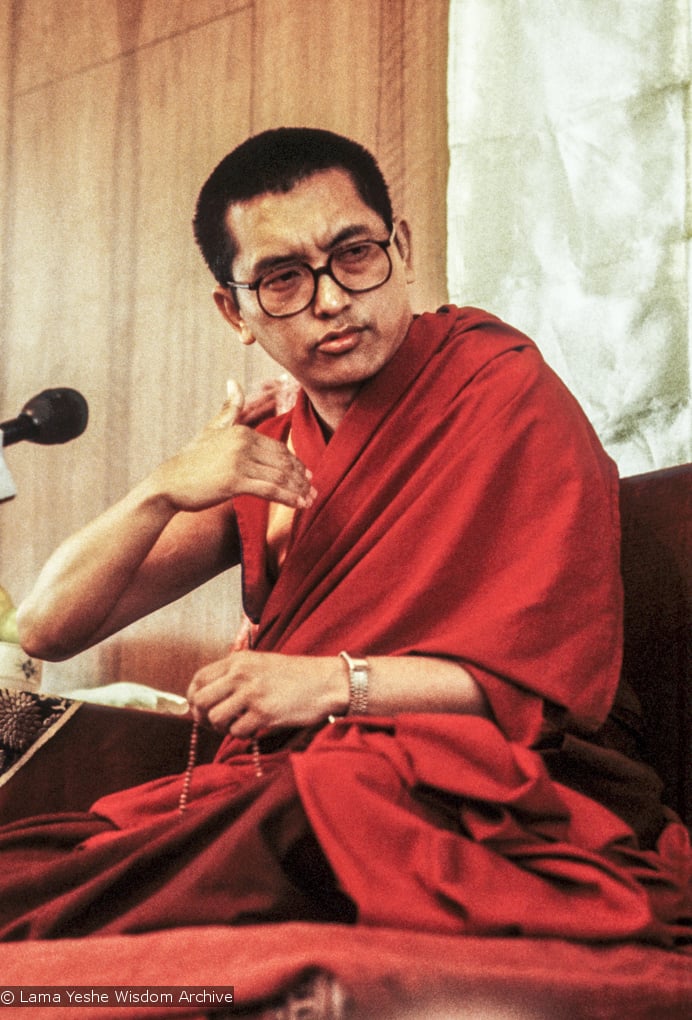 So we’re going to destroy, totally cease, make it completely non-existent, this enemy, this inner enemy, this delusion, this demon, this self-cherishing thought that harms, that has been harming you, torturing you, and all the time, giving you problems all the time, even this life.
So we’re going to destroy, totally cease, make it completely non-existent, this enemy, this inner enemy, this delusion, this demon, this self-cherishing thought that harms, that has been harming you, torturing you, and all the time, giving you problems all the time, even this life.
-Lama Zopa Rinpoche
This month on the LYWA podcast, Lama Zopa Rinpoche gives an introductory teaching during a lamrim retreat at Vajrapani Institute in 2006. In this session Rinpoche impresses upon us the urgent importance of concentrating all our efforts on realizing the stages of the path to enlightenment for our sake and for all sentient beings. Read along with the transcript on our website.
The LYWA podcast contains hundreds of hours of audio, each with links to the accompanying lightly edited transcripts. See the LYWA podcast page to search or browse the entire collection by topic or date, and for easy instructions on how to subscribe.
WHAT'S NEW ON OUR WEBSITE
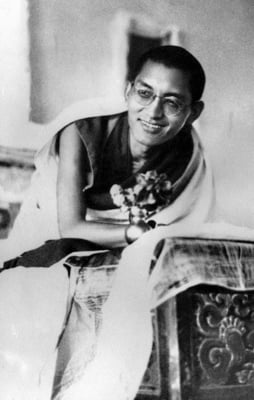 This month we have a new teaching, How to Do Tonglen, to share with you. Lama Zopa Rinpoche gave this teaching on tonglen, the meditation practice of generating bodhicitta by taking on the suffering of others and giving them happiness, at Kopan Monastery, Nepal, in June 2020.
This month we have a new teaching, How to Do Tonglen, to share with you. Lama Zopa Rinpoche gave this teaching on tonglen, the meditation practice of generating bodhicitta by taking on the suffering of others and giving them happiness, at Kopan Monastery, Nepal, in June 2020.
We also have a new free audiobook, The Nectar of Bodhicitta, to share with you. It's now available for listening on Google Play, and in our effort to make these free audiobooks more accessible, especially for people unable to access Google Play, you can also listen to The Nectar of Bodhicitta on the LYWA Youtube channel.
You can check out the entire LYWA audiobook catalog here, which includes some of our most popular books by Lama Yeshe and Lama Zopa Rinpoche, now available as free audiobooks from Google Play and titles for purchase from Audible.
Every month we share new advices for Lama Zopa Rinpoche’s Online Advice Book, adding more than 100 new entries every year on a variety of topics. There are now more than 2,200 of Rinpoche’s precious advices online.
- Remember the Kindness of Sentient Beings: A student saw Rinpoche’s kindness to animals at a retreat and told Rinpoche about the activities they were doing to benefit animals. Rinpoche advised that every sentient being, including every ant and every mosquito, is most precious and kind.
- The Truth Will Win: Rinpoche sent this advice about karma to a student who was having difficulties with tenants who owed thousands of dollars in rent and property damage. The tenants were eventually evicted, but the student found it difficult to generate compassion for them after seeing the full extent of the damage. Rinpoche explained that we should see the people who harm us as the object of our compassion and gave examples from his own experience.
- Meditate on the Lamrim Every Day: Rinpoche advised the importance of lamrim study and practice for a student who had just finished the six-year Basic Program.
- Traumatic Brain Injury and Psychosis: A student wrote that her son had sustained a traumatic brain injury and had developed psychosis and obsessive behavior. Her relationship with her son was difficult, however, he had a connection with Rinpoche and with the Dharma. Rinpoche said to tell her son that the purpose of his life is to benefit others.
You can always find a list of all the newly posted advices from Lama Zopa Rinpoche on our website.
A Heart Project: The Big Love Homemade Audiobook
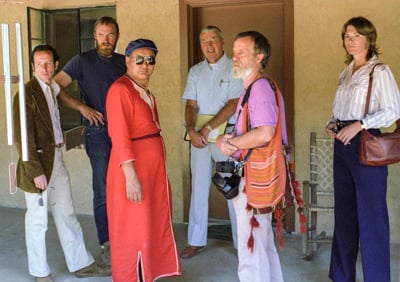 This month we offer you the second Big Love audio installment of the Introduction to Big Love, both written and narrated by Jonathan Landaw, one of Lama's heart students.
This month we offer you the second Big Love audio installment of the Introduction to Big Love, both written and narrated by Jonathan Landaw, one of Lama's heart students.
This heart project is a homemade audiobook version of Big Love: The Life and Teachings of Lama Yeshe, read by people who were there as the story unfolded. It is comprised of narrations recorded by a group of friends of the late Åge Delbanco (Babaji), who was one of Lama Yeshe’s earliest students. Åge was in his 90s when Big Love was published and was having trouble with his eyesight, so his kind friends decided to record it for him but he passed away before it could be finished. With those same friends, we are now completing our recording of Lama's biography and gradually bringing you this informal oral transmission of Big Love in his honor.
Visit here to find the first two installments of Big Love, the homemade audiobook.
As always, we thank you for all your support and interest. We couldn’t do it without you! And remember, if you want to support our free Lamrim Year Companion site, bringing the entire lamrim to all sentient beings, please make your contribution here. Thank you so much.
Big love,

Nick Ribush
Director
This month's Teaching: Lama Yeshe on Dharma in Daily Life
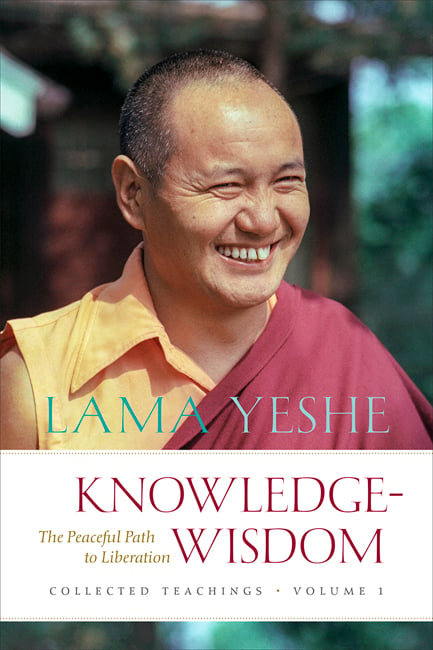 Q. How do we practice Dharma in the West while working full-time and living in the city with many personal and professional commitments? How can we adapt the teachings of the Buddha and integrate them fully into daily life? In what can we take sincere refuge?
Q. How do we practice Dharma in the West while working full-time and living in the city with many personal and professional commitments? How can we adapt the teachings of the Buddha and integrate them fully into daily life? In what can we take sincere refuge?
Lama. How to answer that? Now, first of all, what is Dharma? What is Buddhism all about? It looks like there are so many subjects, so many philosophies, so many meditations, so much psychology. You feel there are so many things going on in Buddhism.
Being really practical, do whatever you can according to your level. I think it’s a gradual path to enlightenment, isn’t it? I cannot say, “This is the way to do it.” If I say, “This is the way it should be,” it’s a joke, it’s not true. It is according to your life, according to your consciousness, your way of developing, your existence.
In Buddhism we say we are not suddenly born from our mama like a mushroom; we have a long history of many, many, many previous lifetimes. Each of us is different and we have different realizations according to our life experiences, our own consciousness or the way we have developed. Do you understand? We are all on different levels.
When we reach enlightenment, buddhahood, we will be at the same level—one universal consciousness—then there is no distinction between you and me, him and her. But at this moment, as long as we are tied up in dualistic, superficial concepts, worldly concepts, we cannot break out of where we are. We are suffocated, full of concepts, full of relative interpretations, full of relative mind. This is our suffocation. There are different degrees of suffocation; that’s why each person should do what they can according to their own level.
In practical terms, what Buddhism really teaches us is to have sympathetic loving kindness toward others and ourselves as well. The second thing Buddhism teaches us is about our ignorance: that we are repeatedly mistaken, repeatedly uncontrolled. It doesn’t matter that we are intelligent, we are repeatedly mistaken, again and again. Sometimes we know something intellectually, but our intellectual understanding is not sufficient; it is just some kind of weak mind and weak life. That doesn’t bring indestructible protection. It takes time.
Buddhism teaches two things: loving kindness for others, which eliminates self-cherishing concepts, and wisdom eliminating ignorant wrong conceptions in order to realize universal reality. I’m sure you’ve heard of shunyata, or the wisdom of emptiness. This is the most important thing for human beings, for all of us. Without wisdom we are already mistaken; we can’t see. Check out how our lifestyle has been. When we choose certain things for our life, sometimes they bring satisfaction, but most of the time they bring us misery and dissatisfaction. So, from all these things, we can see how we make too many mistakes. We have made many mistakes up to now, we are making mistakes at the moment, and we will continuously make mistakes into the foreseeable future. We will, we will; there’s no choice. It’s not something intellectual. It’s just what we are, unfortunately.
We know intellectually that loving kindness and dedication for others is the only way to really bring satisfaction. We have no doubt; we know that. Maybe we have had some experience through the intellect. We can see that without having kindness for others, without dedication for others, there is no way to have satisfaction. It’s the same thing for wisdom.
Wisdom also has many levels, which I’m sure you have heard about. We say “shunyata” but that is just a word. If I ask you people, if I interview each person, asking, “What is shunyata?”—if I pick one person each hour and ask this, everybody will have a different idea. Sometimes shunyata is something to do with experience; sometimes there are no words. Buddha said it is not words. It’s true, the experience of real shunyata is without concepts, without interpretation—we totally lose dualistic concepts.
Describing that experience without words is not possible, but when we use words, we are not open, we are full of concepts. That’s typical; I’m sure all of you have also had some experience of shunyata, but when you describe it in words, somehow it doesn’t come out exactly. I think it never, ever comes. No way.
The essence of Buddhism is true compassion, loving kindness for others and intensive awareness and wisdom—our totality nature. That is Buddhism’s business. So, to do this business, to integrate this into society, you don’t need anything—you don’t need to wear this robe, you don’t need to speak Tibetan words, you can do it in your own language. You don’t need to do Tibetan-style prostrations; you can do Western prostrations. You can transform Tibetan prostrations into a Western way. What I mean is you don’t need to do all these Tibetan rituals—prostrations, prayers, those things. In my opinion you don’t need to do any of these at all.
What you should do is the essence: really learn what true love is and how to practice the techniques for developing it, and how to practice true wisdom. Wisdom is awareness, or comprehension, and knowing what’s going on in your mind. That’s the only business you need to be concerned with. Don’t worry about what’s going on in other peoples’ minds, in your friends’ minds. That’s difficult. First concern yourself with what’s going on in your own mind and try to understand the condition of your own consciousness; how to operate daily and how to go into the universal reality of your own consciousness. That’s the way to integrate.
Also, don’t worry about rituals. Buddhism went to many different cultures—Indian, Tibetan, Chinese, Korean, Thai, Burmese and so forth. Everybody does it differently. Everybody makes different prostrations. Anyway, Buddha himself taught different prostrations to different disciples. It’s never the same. So, as Buddhism goes to the West, it is taking another shape, a Western shape. It’s the only thing to do, so I don’t think you should worry.
If you are thinking, “Only the words, prayers and rituals of Tibetan Buddhism are true; sticking to Tibetan Buddhism is the only way I can practice,” then for sure you won’t be able to integrate it. Your business is to take the real, nuclear essence of Buddhism, not something that you cannot understand, thinking, “The Himalayan mountain way is best.” We’re dealing at sea level.
Buddhism teaches us how to develop loving kindness, but not by merely saying, “You should love everyone.” We explain why we should have love and how to generate it. That is the meditation we should do, but to develop loving kindness there are many other things besides meditation we can do, like helping the poor or the sick. In the West, we have everything and our lives are complicated. We should use our life to serve others and not just space out in meditation. Act physically to help others as much as you can—that is your sadhana. I think that’s all. I can’t see any complication.
Meditation is part of the international language now but I don’t think that you’re bad if you don’t meditate. Meditation is not only sitting; it is also thinking about something. For example, let’s say you have to work until four or five o’clock and when you come back you are already tired, exhausted. So, you get home and maybe lie down and think back on your day—your work, how people reacted, how your mind worked, how many times you became angry, how many times disturbances happened. That’s a kind of meditation, thinking, “Was it worthwhile or not?” I think that’s good enough.
That’s why I say Buddhism is really simple and you don’t need rituals. Maybe lying down is a ritual. I think so. It’s really so simple. It’s a very, very simple way, without involving rituals or any kind of trip. Be yourself. Who can tell you, “Don’t think!” Maybe your friend doesn’t like you to lie down; maybe they want attention. Then, what to do? You can say, “Please give me a little time.” That’s what you have to do. You have to be open in that way. I think that’s all; what else can I say? I think that’s good enough.
For example, visualization may be the biggest problem for you—going back to the West and trying to visualize an Eastern Buddha. When you visualize Buddha, your visualization becomes a Western visualization, don’t you think? Yes! I tell you, it’s my observation. Many Western students are now studying Tibetan thangka painting, but when they draw the Buddha, he looks Western; they can never make an Eastern face. It shows what is here, inside. Visualization is very important. Anyway, in the West we do have visualization. Look at television—that is visualization.
In the West, everything is directed toward sensory pleasure. Normally, visualization is grasping at objects, grasping uptight images. We identify with something about which we fantasize. We work on our self-image, showing our face this way, putting our hair that way. The face should be shown this way, not that old face. We fantasize. We can see how it works in the incredible Western fashions and those things. We can see how deluded people are. They’re all doing something different, being happy or proud of their life, showing “I’m wonderful, beautiful, good.” All right, all right—but all this energy! The motivation, the energy, is unbelievable. I’m scared of all this energy. They have so much suffering. They don’t really suffer physically, but mentally they’re suffering so much.
So yes, we do have visualization. I’m sure you’ve heard that in Buddhism we have archetypal images of the enlightened state of realization—compassion, wisdom and power. Avalokiteshvara is the archetypal image of universal compassion; Manjushri is the archetypal image of universal wisdom; Vajrapani, universal power. These are the archetypes represented by those deities. In Tibet this was commonly understood. We have descriptions of what Avalokiteshvara is, what Manjushri is and what Vajrapani is, and we already have these three qualities now. We have Avalokiteshvara quality; we all have loving kindness to some extent. If somebody loves us, we try to love them, don’t we? We do have love and we do have some wisdom—knowing how to take care of ourselves and how to be happy. We have this now. And we have some power as well. We have the power to move, to resist our miserable situation and to bring pleasurable things close to us. We build nice houses, we eat nutritious food, we seek out good friends. That is our own power.
But our compassion is limited; it’s very, very narrow. For example, English people love the English and they like only English customs. They think the English are respectable and other nations are disasters. Anyway, to really love—to love our nation, to love other nations, to love African people—is so complicated. The problem is we can’t see. We only see our image; we can’t see that black people, African people, are the same as us. It’s a problem. We have the distinctions of nation, color and religion.
When we become Buddhist, I’m sure it’s the same—we look down a little bit on Muslims or Hindus. I tell you, it’s almost impossible not to. That’s why I say it’s completely to do with individual development, individual understanding. We all try, but whatever we try to do just becomes some kind of ego trip. Not totally an ego trip—we mean well—but there’s always something coming sneakily into our mind. We try to meditate, thinking, “Buddhism is good,” then suddenly we discriminate, thinking non-Buddhists are second class. It’s unbelievable. Then, because we are so judgmental, we have no love for Muslim people. Terrible, isn’t it? Then we don’t have love for Hindu people or we don’t have love for Christian people. That’s the way it is. It’s so complicated. Our minds are so narrow.
We should definitely admit our false conceptions, our true experience, our discrimination, but we don’t. We think, “I’m all right, I’m good enough!” That’s complete garbage. We do have compassion, but it’s always limited. That’s why having some kind of being, an archetypal image, is very powerful. We need some way to enhance our loving kindness into universal love. We’re not ready for this totality; we need some kind of sublimation, some kind of archetypal divine quality that does not bring the miserable reaction of discrimination.
Avalokiteshvara is not like a human being—he is our pure energy of loving kindness manifesting as radiant light. This method is so powerful. Instead of going to have a haircut and paying—how much do you have to pay for a haircut? In the West, it must cost at least twenty dollars in order to gain that image. If you emanate yourself as Avalokiteshvara every day, you’ll save money. You are beautiful. Beauty is always there.
We normally identify ourselves in a dualistic, deluded way, a wrong conception way. We make a bubble image of ourselves and believe that we are that bubble image, but it is false. In order to eliminate this false image, we emanate as a deity. So, visualization is extremely powerful. You can see how Western visualization is so powerful. When you see something on television, you have no choice: you have to go out and buy it. That is the power of visualization. So, visualization is very important. That’s why, when you go back to the West you should put the Buddha’s image in your room instead of a disaster image, instead of—what is it that young Eastern people like? [Bruce Lee, kung fu.] Yes, that one. Pictures everywhere. Even my young Kopan monks keep this one. Instead of putting up the kind of thing that gives us anger energy and nonsense, put up a Buddha image. It is so peaceful; always looking very peaceful and compassionate. When we look at the Buddha, we feel something. It’s useful, because we are not yet beyond form and color. We are dependent on form and color; that’s why visualization is very useful. All right, I don’t want to talk too much.
Lama Yeshe answered this question at the sixteenth Kopan meditation course. Excerpted from a new Lama Yeshe book, Knowledge-Wisdom: The Peaceful Path to Liberation. Collected Teachings, Volume 1. Compiled by Sandra Smith, edited by Nicholas Ribush and Uldis Balodis. Forthcoming from LYWA, spring 2023.
























